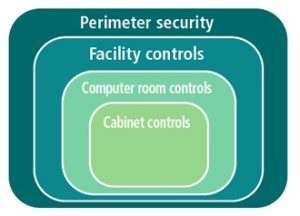
We often realise how precious something is only when we no longer have it available. With the invisible digital data so strictly linked to our daily life, this is the case, for the individual as for all companies up to large entities. It is therefore right to include among critical infrastructures Data Centres, i.e. the places where digital data are stored. As a matter of fact, violation of those high-value intangible assets can create huge damages not only financially but also to the reputation of companies. Here Cias looks at how companies might protect those assets both physically and virtually and discreetly.
The heart of the data centre is all the IT equipment needed to store data: servers, switches, routers, power and cooling infrastructures, and telecommunications equipment, usually housed in bulky cabinets. Depending on the size of the data centre, at a simpler level this can occupy a single building, perhaps located in a shared space, or a cluster that covers a large area mostly located outside the town for greater security. Recently, to contain the environmental impact of these highly energy-intensive plants, the most sustainable data centres are powered by a photovoltaic field in the same area.
The securing of data centres cannot be limited to – perhaps more obviously – virtual network protection measures from cyber attacks aimed to steal sensitive data, such as hacking, malware and spyware, but must also include adequate physical solutions to prevent unauthorised access to infrastructure. Physical security as a whole includes all protocols for the prevention of damage to electronic equipment, whether these derive from natural disasters or whether they are the result of sabotage, industrial espionage or terrorist attack aimed at service disruption.
Among the physical attack prevention techniques there are structural measures such as the concentration of the entrance on a single access point, turnstiles, fences and other physical barriers, private guards and CCTV system. In synergy with these measures a first line of defence must be implemented, to intercept the attempted intrusion and prevent it from succeeding, that is the role of the perimeter intrusion detection system.
In the case of a big data centre deployed in many buildings, they are located in a large outdoor area that needs to be protected. Environmental conditions must also be taken into account, for which microwave barriers are an ideal solution. For example, the Cias Ermo 482X Pro 3.0, a digital microwave barrier with fuzzy logic analysis for extreme security that is IP-ready; or the Micro-Ray, an innovative barrier with linear microwave rays offering high protection in narrow corridors and it is also IP-ready.
No doubt an integrated solution with various systems working in connection is the best option, says Cias, preventing data theft or damages to equipment even before the software security is put to the test. The identification of the most appropriate defence technology will therefore start from the site’s risk assessment.
For these types of applications Cias also suggests the Synapses, a new self-adaptive multi-sensor system offering effective integration between CCTV video areas and perimeter sensors.











